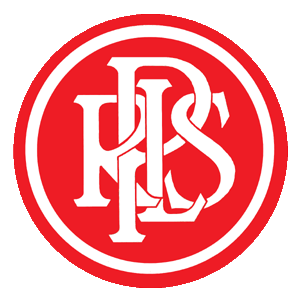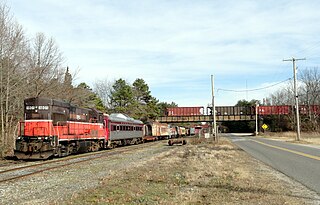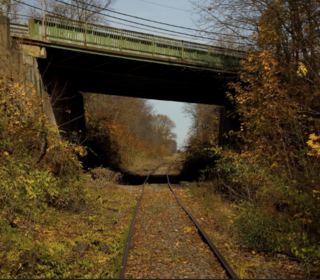
Route 55 is a freeway in the southern part of the U.S. state of New Jersey. Also known as the Veterans Memorial Highway, it runs 40.54 miles (65.24 km) from an intersection with Route 47 in Port Elizabeth north to an interchange with Route 42 in Gloucester County. The Route 55 freeway serves as a main road through Cumberland and Gloucester counties, serving Millville, Vineland, and Glassboro. It is used as a commuter route north to Philadelphia and, along with Route 47, as a route from the Delaware Valley to the Jersey Shore resorts in Cape May County. Route 55 has a posted speed limit of 65 miles per hour (105 km/h) for most of its length.

The River Line is a hybrid rail line in southern New Jersey that connects the cities of Camden and Trenton, New Jersey's capital. It is so named because its route between the two cities is parallel to the Delaware River.

NJ Transit Rail Operations is the rail division of NJ Transit. It operates commuter rail service in New Jersey, with most service centered on transportation to and from New York City, Hoboken, and Newark. NJ Transit also operates rail service in Orange and Rockland counties in New York under contract to Metro-North Railroad. The commuter rail lines saw 57,179,000 riders in 2023, making it the third-busiest commuter railroad in North America and the longest commuter rail system in North America by route length.

Cape May Seashore Lines is a short line railroad in southern New Jersey that operates both freight trains and excursion trains. It offers two excursion services: a 30-mile (48 km) round trip between Richland and Tuckahoe along the Beesley's Point Secondary railroad line and a 14-mile (23 km) round trip between Rio Grande, Cold Spring Village, and Cape May City along the Cape May Branch. The track is owned by NJ Transit and leased to the Seashore Lines. The Cape May Branch is the original line operated by the Cape May Seashore Lines and runs from Cape May north to Tuckahoe, connecting to the Beesley's Point Secondary in Tuckahoe. Cape May Seashore Lines operates freight service along the Beesley's Point Secondary line between Winslow and Palermo, interchanging with Conrail Shared Assets Operations in Winslow. Tony Macrie has been president of the Seashore Lines since he formed the railroad in 1984.

The Pennsylvania-Reading Seashore Lines was a railroad that operated in South Jersey in the 20th century. It was created in 1933 as a joint consolidation venture between two competing railroads in the region: the Pennsylvania Railroad and the Reading Company.
Conrail Shared Assets Operations (CSAO) is the commonly used name for modern-day Conrail, an American railroad company. It operates three networks, the North Jersey, South Jersey/Philadelphia, and Detroit Shared Assets Areas, where it serves as a contract local carrier and switching company for its owners, CSX Transportation and the Norfolk Southern Railway. When most of the former Conrail's track was split between these two railroads, the three shared assets areas were kept separate to avoid giving one railroad an advantage in those areas. The company operates using its own employees and infrastructure but owns no equipment outside MOW equipment.

The Atlantic City Line (ACL) is a commuter rail line operated by NJ Transit (NJT) in the United States between Philadelphia, Pennsylvania and Atlantic City, New Jersey, operating along the corridor of the White Horse Pike. It runs over trackage that was controlled by both the Pennsylvania Railroad (PRR) and the Pennsylvania-Reading Seashore Lines. It shares trackage with SEPTA and Amtrak on the Northeast Corridor (NEC) until it crosses the Delaware River on Conrail's Delair Bridge into New Jersey.

Trenton Transit Center is the main passenger train station in Trenton, New Jersey. Located along the Northeast Corridor, it is served by Amtrak intercity trains plus NJ Transit and SEPTA Regional Rail trains. It is the southern terminus of the NJ Transit Northeast Corridor Line and the northern terminus of the SEPTA Trenton Line. It is also the northern terminus of the NJ Transit River Line service and a terminal for NJ Transit and SEPTA buses.
Railroad electrification in the United States began at the turn of the 20th century and comprised many different systems in many different geographical areas, few of which were connected. Despite this situation, these systems shared a small number of common reasons for electrification.

Pavonia Yard is a Conrail Shared Assets Operations (CSAO) rail yard in Camden, New Jersey.

The Southern Railroad of New Jersey is a small short-line railroad company based in Winslow Township, New Jersey. The railroad operates freight trains in two areas in Southern New Jersey. In the Winslow area, trains operate between Winslow Junction and Pleasantville, and between Winslow Junction and the Winslow Hot Mix asphalt plant in Winslow Township. In Gloucester County, the company operates on the Salem Branch between Swedesboro, New Jersey and Woodbury.
The Millville and Glassboro Railroad was a railway company in the United States. It was incorporated in 1859 and began operating between Millville, New Jersey, and Glassboro, New Jersey, in 1860. The company was merged into the West Jersey Railroad, a forerunner of the Pennsylvania-Reading Seashore Lines, in 1868. Today its line is part of the Vineland Secondary.
The West Jersey and Seashore Railroad (WJ&S) was a railway company in the U.S. state of New Jersey with a connection to Philadelphia. It was formed through the merger of several smaller roads in May 1896. At the end of 1925 it operated 379 miles (610 km) of road on 717 miles (1,154 km) of track; that year it reported 166 million ton-miles of revenue freight and 332 million passenger-miles. The Pennsylvania Railroad leased the company in 1930; this lease was transferred to the Pennsylvania-Reading Seashore Lines in 1933. Its property was conveyed to Conrail in 1976.
The Amboy Branch is a railway line in the state of New Jersey, in the United States. It was the original main line of the Camden and Amboy Railroad, and at its fullest extent ran 61 miles (98 km) from South Amboy, New Jersey, to Camden, New Jersey. The line was built between 1830 and 1834 by the Camden and Amboy, and eventually became part of the Pennsylvania Railroad's network. Ownership of the line today is split between Conrail Shared Assets Operations and NJ Transit, whose River Line uses the branch between Camden and Bordentown, New Jersey.

Penns Grove Secondary is a rail freight line in the Delaware Valley in the southwestern part of New Jersey. Part of Conrail's South Jersey/Philadelphia Shared Assets it runs for approximately 20 miles (32 km) between its southern terminus at Penns Grove and Woodbury at the north where it joins the Vineland Secondary about 8.5 miles (13.7 km) south of Pavonia Yard in Camden. At its southern end the Deepwater Point Running Track continues another 3.7 miles (6 km) through Carneys Point to Deepwater.

The Glassboro–Camden Line (GCL) is a planned 18-mile (29 km) diesel multiple unit (DMU) light rail system to be located in South Jersey.

The Salem Branch is a rail freight line in the southwestern part of New Jersey in the United States between the Port of Salem and Woodbury Junction where it and the Penns Grove Secondary converge with the Vineland Secondary, approximately 8.5 miles (13.7 km) south of Pavonia Yard in Camden.

Woodbury is a defunct commuter railroad station in the city of Woodbury, Gloucester County, New Jersey. Located at the junction of Station Road and Cooper Street, the station served multiple lines of the Pennsylvania-Reading Seashore Lines and the Pennsylvania Railroad. Trains out of Woodbury serviced lines to Salem, Millville, Penns Grove/Carneys Point and Cape May. Woodbury station consisted of two side platforms and a 72-by-20-foot brick station depot.

Glassboro is an inactive train station in Glassboro, New Jersey which served passengers from 1863–1971. Its station house was restored c. 2015. It is located at the edge of the Rowan University campus. Listed as the West Jersey Rail Road Glassboro Depot, it was added to the National Register of Historic Places on April 14, 2020, for its significance in architecture and transportation.

Westville is a defunct commuter railroad station in the borough of Westville, Gloucester County, New Jersey. The station served trains on the former Pennsylvania-Reading Seashore Line branch between Millville and Camden. Westville station contained two side platforms located next to U.S. Route 130 and Station Avenue. The next station to the north was Brooklawn, while South Westville served as the next station to the south.















